Cesar E. Chavez Avenue Viaduct
1926 – Merrill Butler
Cesar E. Chavez Avenue between Mission Road and Vignes Street – map
Declared: 8/1/79
What’s today called the Cesar E. Chavez Avenue Viaduct was the second span realized as part of a major bridge-building program in Los Angeles begun in the mid-1920s (the one at Ninth Street, or the Olympic Boulevard Bridge, built by the North Pacific Construction Company, was the first completed). Lead by the Chamber of Commerce, a collection of groups started lobbying hard in the spring of 1923 for the replacement of six of the city’s outdated bridges and viaducts, but mainly at First, Seventh, Ninth, and Macy Streets.
Now, there had been a couple of bridges over the years connecting Macy Street with Brooklyn Avenue in Boyle Heights (or with Pleasant Avenue in East Los Angeles, depending on when you lived). In fact, the first span over the Los Angeles River was a covered bridge, lit with kerosene lamps, built on this spot in 1870 (has anyone seen a photo of that bridge?). By 1923, however, you would cross the L.A. River at Macy on the metal truss bridge pictured below. What was a particular drag was, while crossing, you were required to contend with the trains of both the Santa Fe (on the eastern side) and the Union Pacific (on the western), as the tracks for each were at the same grade as the bridge’s. Hoping the tracks would be lowered, this brought the Chamber of Commerce to recommend the railroads pay for at least the cost of the new span’s approaches.
The penultimate Macy Street Bridge, from the L.A. Public Library Photo Collection
On June 5, 1923, the electorate voted for a $2 million bond issue to be put toward the big bridge initiative. A few months later, in September, City Council asked the State Railroad Commission to figure an equitable way for the city, the county, the Santa Fe Railroad, the Los Angeles and Salt Lake Railroad Company, the Pacific Electric Railway Company, and the Los Angeles Railway Corporation to all chip in for the project.
When the city presented plans to the State Railroad Commission in mid-July 1924, the projected cost for the new Macy Street Viaduct was estimated at $507,261.70. In addition to that half a million, there was another $94,000 to pay for damages to “abutting property” and $378,578 for the Santa Fe and Union Pacific’s estimates at lowering their tracks. (I should point out here I’ve seen several figures as to how much the viaduct ultimately cost – nearly all from contemporary accounts in the L.A. Times. These tallies include $400,000, $450,000 (including rights of way), $516,000, $655,000, and even a million dollars.)
The city’s bridge engineer, Merrill Butler, oversaw the design of the viaduct while H.P. Cortelyou, construction engineer, and Ross H. Rook, inspector of public works, supervised the construction. The Atkinson-Spicer Company, who had the lowest bid in May 1925 of $324,824.50, were the contractors. While a small legal to-do had construction delayed until August 1925, the builders finished the viaduct a few months early. The Macy Street Viaduct opened formally on April 17, 1926.
Do you know why the bridges features elements of the Spanish Colonial persuasion? It turns out Macy Street/Cesar Chavez Avenue was once part of the El Camino Real, the road linking the twenty-one missions up and down Alta California from San Diego to Sonoma. To further drive home the connection, the city dedicated the span to the founder of the missions, Father Junipero Serra. A pair of plaques on the bridge says so. Here’s the one less tagged:
The viaduct is seventy-one-feet wide, large enough to have originally accommodated a pair of tracks for the Los Angeles Railway. It stretches 1270 feet, and boasts a central span of about 215 feet in length. If you look at the porticos’ cornices, you’ll even see the city seal of Los Angeles.
On opening day that spring of 1926, there was all the usual speechmaking and ceremonies – including the ribbon-cutting and main address by Mayor George Cryer – along with a contractor-sponsored luncheon under the bridge for about 300 guests. The picture below shows how, apparently, the opening day picnickers lacked the good sense to clean up after themselves.
Oh, and there’s a story behind the pair of $600 memorial bronze plates you can find on the bridge, too. In April 1926, City Council voted to add its members’ names to the viaduct’s tablets, pointing to the fact the recently completed Ninth Street Bridge had plaques bearing the names of the Mayor, the Board of Public Works, and engineers, “but no mention of the men who did the heavy work and who raised the money” (i.e. City Council). The board of Public Works, though, shot down the idea pronto, pissing off council to no end.
Views north of the viaduct (a bonus):
A seismic retrofit was completed on the bridge in 1995, right around the same time the city decided Los Angeles pioneer Dr Obed Macy really wasn’t worthy of the honor of having a street named after him those century-plus years. (Actually, while Macy Street and Brooklyn Avenue were renamed to honor labor leader Cesar Chavez, there’s a chance the Macy Street Viaduct may have kept its name. I shouldn’t assume just because the street was renamed, so too was the bridge. A quick call to the Board of Public Works can answer the question, so someone let me know how that turns out.)
Sources:
“Start Move to Obtain Bridges” The Los Angeles Times; Mar 27, 1923, p. II5
“Bridge Cost Division Urged” The Los Angeles Times; Sep 26, 1923, p. II1
“Macy Viaduct Plan Offered” The Los Angeles Times; Jul 16, 1924, p. A8
“Macy Viaduct Contract Let” The Los Angeles Times; May 18, 1925, p. A3
“Councilmen Vote Honor for Selves” The Los Angeles Times; Apr 8, 1926, p. A2
“Council not to Live in Bronze” The Los Angeles Times; Apr 10, 1926, p. A1
“Macy Viaduct is Completed” The Los Angeles Times; Apr 18, 1926, p. E13
“Macy Street Span Opened” The Los Angeles Times; Apr 18, 1926, p. 17
“Municipal Art Commission, Los Angeles, Annual Reports 1921-1929” 1929 Los Angeles, CA
Up next: Los Angeles Theatre
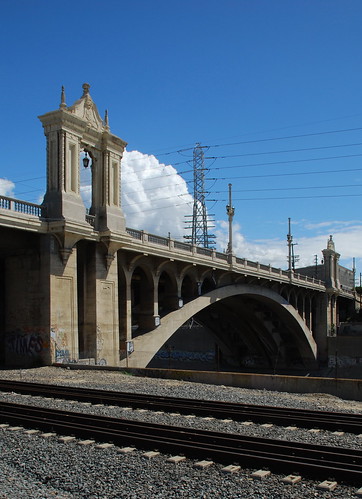
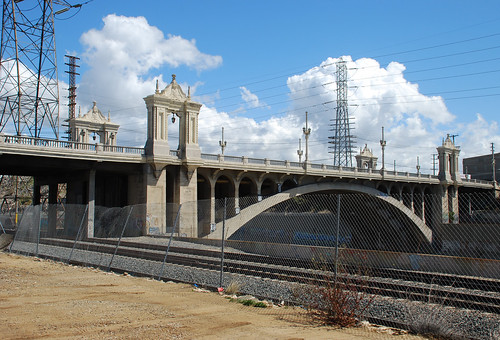
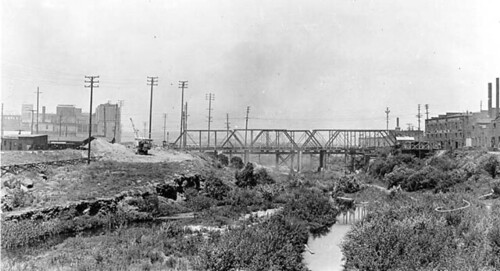

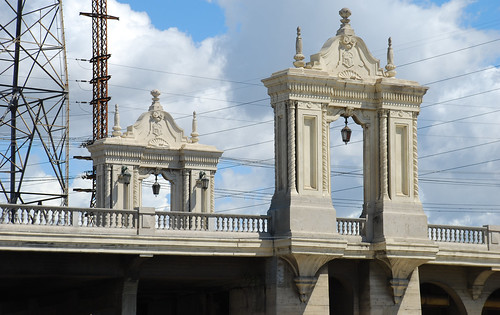
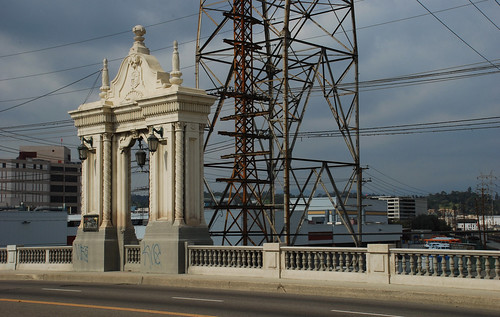

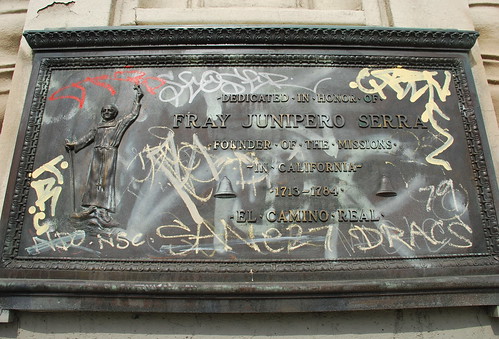
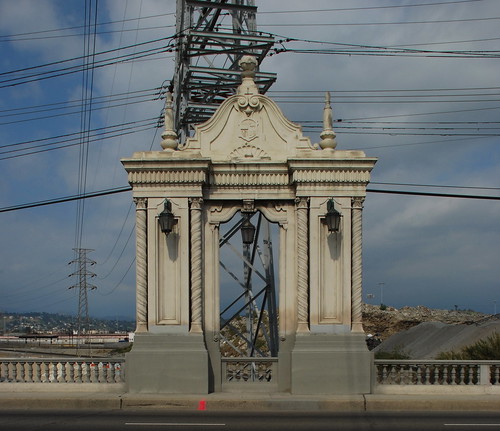

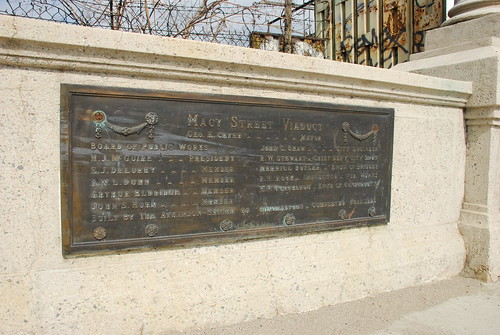
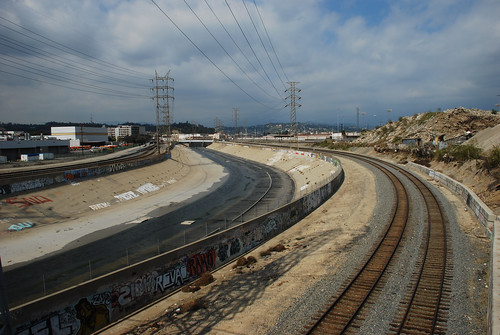

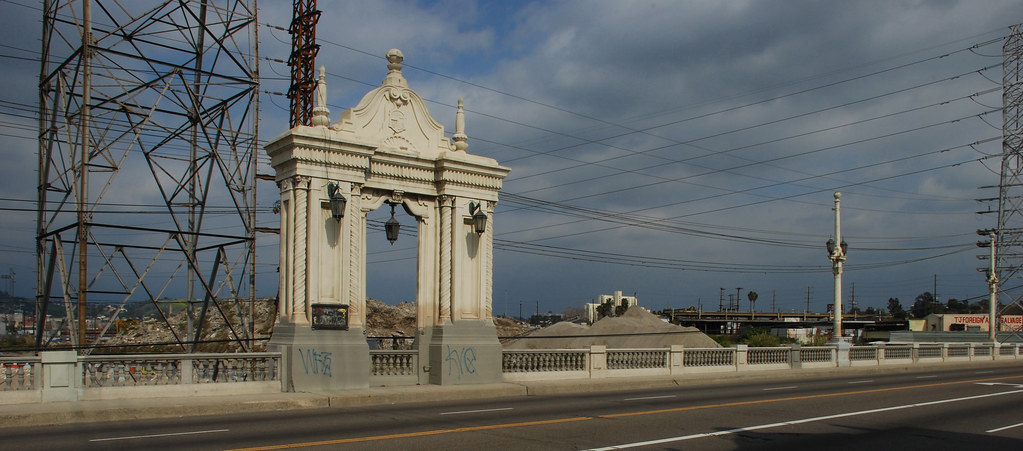

8 comments:
I still call it the Macy Street Bridge. I wish I could have seen the covered bridge version.
I've never walked the length of this bridge. Your beautiful photos have aroused my curiosity. Also, what a swell photo of the Los Angeles river; back when it ran wild.
Another great post! I've been over that bridge a zillion times, but never knew its history, although out of sheer cussedness I still refer to it as the Macy Street Bridge.
I also insist upon referring to MacArthur Park as Westlake Park, in the fond (but probably misguided) hope that someday the Powers That Be will decide to return the park to its original name.
Great Blog! Do you lead tours or is this an individual effort?
I've always loved this bridge and appreciate knowing it's history as well. Thanks, Floyd!
Greetings all,
how wonderful it would been to be alive when this beautiful bridge was constructed. My partner Wallace Woodworth and I were commissioned to build a second and more substantial bridge across the river in 1870 when the older foot bridge of old Aliso Street (now Macy Street) was washed away in the great flood of 1867-68; it was built for a sum of $20,000. I had great pride in the bridge as it afforded me easier transportation from my home on Mount Pleasant (now Pleasant Ave) to my lumber mill on Alameda Street between Commercial and Requina Streets. Unfortunately, the bridge constructed by Mr. Woodworth and myself would also fall to the fate of the rushing waters of the Los Angeles river.
W.H.
Thanks for the comments, everyone. No, Mike, I don't give tours; the blog's a hobby is all. Thanks for the compliment.
I can see you're no longer blogging but I get homesick and I like looking at your many photos and reading the histories.
This is probably the most filmed bridge in LA as it is always used in chase scenes and medium shots of movement throughout the city, never mind the LA River aqueduct below. Love it.
Post a Comment